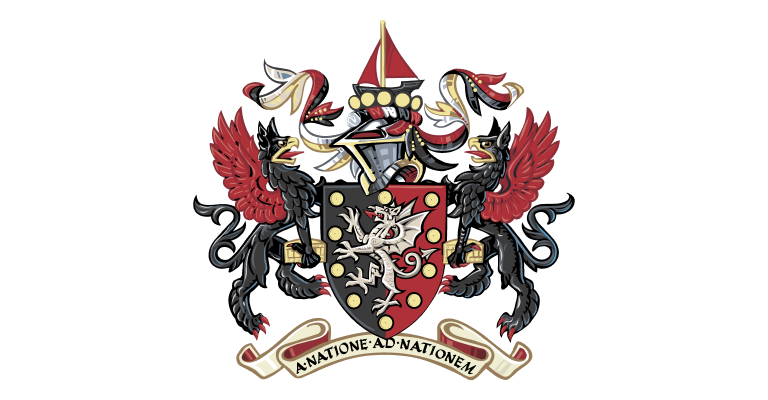More detailed history
Read more about the history of the WCIB

The Coat of Arms
The Crest and Helm
The Crest is an important part of the achievement (the word is derived from Latin crista, a cock’s comb). The “comb” ran from the forehead over the crown and was originally a reinforcement to lessen the impact of a blow. The idea of including a Helm in the representational display of arms presumably arose from the observation that, as Crests were all different and some had hereditary or other special significance or were derived from associated devices, they were as distinctive in their way as shields.
The Company Crest (a Bermuda Sloop) was taken from the badge of the Overseas Bankers Club (OBC) and slightly modified. The reason for using the ship was to continue the historical traditions passed down from the OBC to the Company and to represent the internationalism of the Company. The ship sits on five gold bezants (gold coins that were first minted in Byzantium and England for use by merchants) representing the five major continents. The point at which the Crest was attached to the Helm by rivets or laces seems to have been disguised in various ways, for example by twisting around it a plain band of cloth or a lady’s “favour”, and from this developed the wreath or torse of heraldry. It is shown now as a twisted ribbon of two or more colours. The “mantling” emanating from the Helm originated from the need to insulate the metal helm from the heat of the sun with a small mantle, which predictably was made into a handsome adjunct to the outfit.
The Shield
The Shield is divided vertically with one half black, the other red (credit and debit) with a white dragon rampant (the City of London Dragon) as the principal charge, within an orle (circle) of bezants.
The Supporters
The Supporters are Griffins, the “guardians of treasure” and to make them unique, each holds a 13th century “pyx” chest (treasure chest).
The Motto
The motto literally translates as “Nation to Nation” to represent the internationalism of the Company.

The Oral History Project
In 2015, The Company teamed up with Cambridge University’s Centre for Financial History to create an Oral History Project and archive. The project aims to provide members and researchers with an audio resource of interviews with key players in major banking events. For each interview there is a transcript with explanatory and contextual notes.
The project aims to provide a timeline from the Secondary Banking Crisis of 1973-75, via Old City, New City including Big Bang, the Global Financial Crisis and the other highs and lows of City banking to the present day. The project’s archive is housed at the Centre for Financial History at Cambridge University (www.centreforfinancialhistory.org).
We are grateful for the support of Duncan Needham, Dean of Darwin College, who heads the Centre.
Our archive of interviews with key players offers a unique perspective on these events and their impact on the financial sector and proves to be of interest to people in financial services and beyond.
Interviews and transcripts
The Secondary Banking crisis of 1973-75, threatened to bring down the banking system. Known as ‘the Lifeboat’ and organised by the Bank of England, the English and Scottish clearing banks between them lent over £1bn, equivalent to 40% of their capital and reserves, to the secondary banking sector to save the financial sector and, by extension, the UK economy.
The City saw great changes in the period leading up to “big bang” (The deregulation of the London Stock Exchange) with a complete transformation of much of banking & broking. These interviews cover much of this activity and its aftermath.
The 1990s saw further change and consolidation of City firms, again we have interviewed those closely involved this. Further regulation, even more competition and the importance of foreign banks and firms, together with a huge increase in derivatives trading were hallmarks of this decade.

Find out more about joining
Expand your network and participate in charitable activities.

Book your place at an event
Browse, book and save the date for a variety of events ranging from networking, market knowledge and formal to some lighter touch socials.
